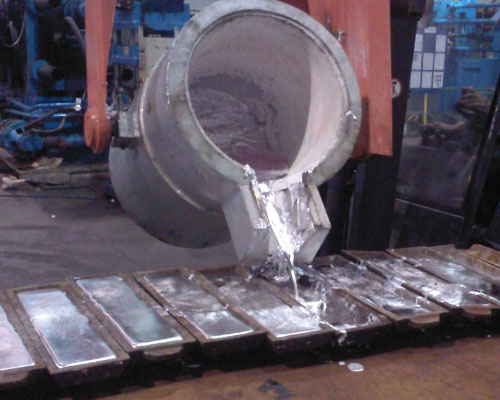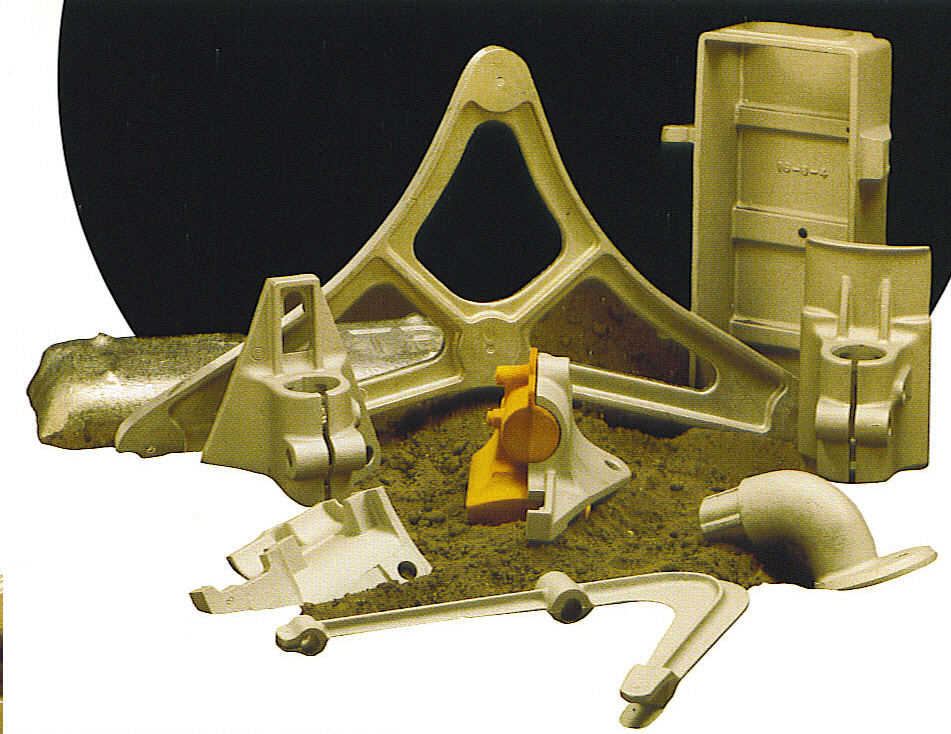How Aluminum Foundry Adds To Cutting-edge Solutions in Metal Manufacture
Aluminum factories substantially influence the landscape of steel manufacture. They adopt innovative casting strategies that boost precision and design adaptability. This ability allows for the production of light-weight and sturdy components that deal with diverse market needs. Moreover, the assimilation of automation and sustainable practices establishes a standard for performance. As these factories develop, they question about the future of manufacturing and the duty of innovation fit the market.
The Function of Aluminum Foundries in Modern Production
Aluminum factories play a necessary role in contemporary manufacturing, contributing substantially to various industries, including automobile, aerospace, and durable goods. These centers specialize in the melting and spreading of aluminum, transforming raw products right into top notch parts that meet rigorous sector standards. The light-weight yet strong residential or commercial properties of Aluminum make it an optimal option for manufacturers intending to boost efficiency while minimizing weight, especially in the auto industry, where gas effectiveness is critical.
Moreover, Aluminum factories make use of cutting-edge procedures to generate intricate shapes and designs that deal with certain market needs. By leveraging sophisticated technologies such as computer-aided layout and simulation, these shops can maximize their manufacturing processes and improve product application. This not only boosts the high quality of the final items but additionally decreases waste, contributing to more sustainable production techniques. Ultimately, the payments of Aluminum factories are vital for driving technology and efficiency across numerous industries.
Advanced Spreading Techniques Changing Steel Construction
Advanced spreading methods are transforming the field of steel manufacture, particularly through precision spreading techniques that enhance precision and lower waste. Ingenious alloy advancements are likewise playing an important function, enabling tailored residential properties and improved performance in different applications. With each other, these improvements are establishing new standards in efficiency and top quality within Aluminum foundries.
Precision Spreading Methods
As the demand for top quality parts in various sectors continues to climb, accuracy spreading techniques have actually become a transformative pressure in steel fabrication. These strategies, including financial investment casting, shed foam casting, and die casting, permit detailed geometries and limited tolerances that standard techniques usually battle to achieve. By using innovative products and technologies, accuracy spreading minimizes waste and improves performance, enabling producers to produce complex parts with lowered preparations. In addition, these approaches offer premium surface area finishes and mechanical residential or commercial properties, making them ideal for markets such as aerospace, vehicle, and medical tools. As makers increasingly take on accuracy casting, the ability to meet specific layout needs while keeping cost-effectiveness ends up being a pivotal advantage in today's competitive market.
Cutting-edge Alloy Advancements
Ingenious alloy growths are improving the landscape of steel construction, especially within the domain of precision spreading. Advances in material science have led to the development of specialized Aluminum alloys that boost toughness, sturdiness, and resistance to corrosion. These novel alloys allow foundries to generate intricate parts with improved mechanical properties, accommodating varied markets such as aerospace, automobile, and electronic devices. The unification of sophisticated casting techniques, including die spreading and sand casting, more maximizes making use of these products, permitting intricate geometries and decreased waste. Consequently, producers are much better outfitted to meet rigorous performance standards while decreasing ecological influence. Inevitably, these ingenious alloys are paving the method for a new age of performance and sustainability in metal construction.
Light-weight and Durable: The Benefits of Aluminum Components
Aluminum elements provide significant advantages in numerous applications as a result of their lightweight nature and durability. This combination adds to enhanced fuel effectiveness, particularly in the aerospace and auto industries. Furthermore, light weight aluminum's inherent rust resistance further expands the lifespan of items, making it a favored choice in numerous steel fabrication processes.
Enhanced Fuel Performance
While typical products have long been the standard in various markets, the shift towards Aluminum components is revolutionizing the landscape of steel manufacture, specifically in regard to boosted gas performance. Light weight aluminum's lightweight nature notably minimizes the total weight of cars and machinery, enabling enhanced performance and minimized energy usage. This reduction in weight translates directly to reduced gas consumption, making Aluminum an appealing alternative for suppliers intending to fulfill stringent environmental laws. Furthermore, aluminum's sturdiness warranties that elements keep their honesty over time, adding to long-lasting efficiency. As sectors significantly prioritize sustainability, the fostering of Aluminum components becomes a strategic option, straightening operational objectives with ecological responsibility while enhancing gas performance in numerous applications.
Deterioration Resistance Advantages
Among the standout functions of Aluminum parts is their extraordinary corrosion resistance, which substantially boosts the longevity and dependability of different applications. This residential or commercial property is particularly helpful in severe environments, such as aquatic and industrial settings, where direct exposure to wetness and chemicals can bring about considerable deterioration in other steels. Unlike steel, Aluminum naturally forms a safety oxide layer that acts as a barrier against ecological aspects, decreasing the threat of corrosion and rust. Therefore, Aluminum elements require much less maintenance and have a longer life span, making them an economical selection for suppliers. This inherent toughness not just adds to the total efficiency of items but additionally supports sustainability efforts by minimizing the requirement for frequent substitutes.
Innovations in Style and Design Via Aluminum Foundries
As innovations in Aluminum Foundry technology remain to reshape the landscape of steel construction, ingenious style and design services are arising to satisfy the demands of varied sectors. The versatility of Aluminum enables elaborate layouts that were formerly unattainable with conventional products. Foundries are leveraging computer-aided design (CAD) software application and simulation devices to maximize the style procedure, allowing designers to produce light-weight yet robust elements customized to details applications.
The capacity to include innovative alloying strategies allows the customization of Aluminum homes, improving stamina and longevity. This flexibility fosters creative thinking in product development, allowing business to try out brand-new forms and structures that enhance capability while minimizing weight. Collaborative initiatives between designers and shops promote fast prototyping, resulting in shorter task timelines and boosted total efficiency. These innovations not just enhance product efficiency yet likewise drive sustainability by decreasing material waste throughout the construction procedure.
Enhancing Performance With State-Of-The-Art Innovation
Improvements in cutting edge modern technology are revolutionizing the performance of Aluminum factories, improving processes from layout to manufacturing. Automation plays a crucial role, with robot systems improving the speed and precision of jobs such as molding, putting, and completing. These automated solutions decrease human error and decrease labor prices, while also boosting output consistency.
Furthermore, the combination of sophisticated software program for computer-aided style (CAD) and simulation enables quick prototyping and screening, expediting the change from idea to manufacturing. Foundries are using real-time information analytics to monitor procedures, making sure peak efficiency and reducing downtime.
3D printing modern technology is being adopted for producing complex mold and mildews and parts, decreasing product waste and lead times. The combination of these innovative modern technologies not only enhances performance but additionally improves the top quality of Aluminum items, placing shops at the forefront of development in metal construction.
Sustainable Practices in Aluminum Foundries
An expanding variety of Aluminum factories are embracing sustainable methods to reduce their ecological influence and advertise resource effectiveness. Wisconsin Aluminum Foundry. These foundries are increasingly executing reusing programs, where scrap Aluminum is accumulated and reprocessed, significantly reducing waste. Additionally, energy-efficient innovations, such as electric heaters and advanced insulation materials, are being utilized to lower power intake during the melting procedure
Water preservation strategies are likewise gaining traction, with lots of shops recycling water in cooling down systems to decrease general usage. Moreover, the fostering of environment-friendly layers and additives minimizes hazardous emissions without endangering item high quality.
Future Trends in Aluminum Casting and Metalworking
Significantly, the future of Aluminum spreading and metalworking is being shaped by technical advancements and advancing sector standards. Developments check my blog in automation and robotics are streamlining procedures, enhancing accuracy, and minimizing labor expenses. The adoption of additive production techniques, such as 3D printing, is changing typical casting methods, permitting intricate geometries and decreased product waste.
The combination of man-made knowledge and data analytics is allowing real-time surveillance and predictive maintenance, which maximizes manufacturing performance. Sustainability remains a core emphasis, with firms buying green practices, consisting of the recycling of Aluminum scrap and the usage of eco-friendly energy resources in production.
As the demand for light-weight, sturdy products in various sectors increases, Aluminum shops must adapt by enhancing and establishing innovative alloys casting techniques. These fads collectively indicate a future where Aluminum casting and metalworking are a lot more reliable, lasting, and receptive to market demands.

Often Asked Concerns
What Types of Aluminum Alloys Are Typically Utilized in Foundries?
Frequently utilized Aluminum alloys in foundries include 2xxx collection (copper), 3xxx collection (manganese), 4xxx series (silicon), 5xxx collection (magnesium), and 6xxx series (magnesium and silicon), each offering unique homes appropriate you can find out more for numerous applications.
How Does Aluminum Spreading Contrast to Other Steel Fabrication Techniques?
Aluminum casting deals benefits such as reduced production prices and complex forms compared to conventional construction methods. It gives excellent dimensional precision and surface coating, making it a favored choice for several industries over alternatives like machining or welding.
What Safety Measures Are Implemented in Aluminum Foundries?
Aluminum shops execute numerous precaution, including individual protective tools, ventilation systems, normal security training, hazard analyses, and useful content emergency situation protocols to safeguard workers from risks related to liquified metal, warmth, and possible chemical direct exposure. Aluminum Foundry.
Exactly How Can Business Find Reputable Aluminum Foundry Allies?
Companies can determine reliable Aluminum Foundry companions by assessing market track record, examining customer reviews, assessing quality certifications, thinking about production abilities, and conducting website brows through to assure positioning with their details demands and criteria.

What Is the Common Lead Time for Aluminum Casting Projects?
The normal preparation for Aluminum casting jobs ranges from two to 8 weeks, depending upon aspects such as design intricacy, manufacturing quantity, and the factory's capacity to fulfill details job requirements and timelines.
Aluminum foundries play an essential function in modern production, adding considerably to different sectors, consisting of auto, aerospace, and consumer goods. As advancements in Aluminum Foundry modern technology proceed to reshape the landscape of steel fabrication, cutting-edge layout and engineering solutions are arising to satisfy the demands of diverse markets. Advancements in modern modern technology are transforming the performance of Aluminum factories, streamlining processes from layout to production (Aluminum Castings). An expanding number of Aluminum foundries are taking on sustainable techniques to decrease their environmental impact and promote resource efficiency. As the demand for light-weight, resilient materials in numerous industries boosts, Aluminum factories need to adapt by establishing cutting-edge alloys and boosting spreading strategies